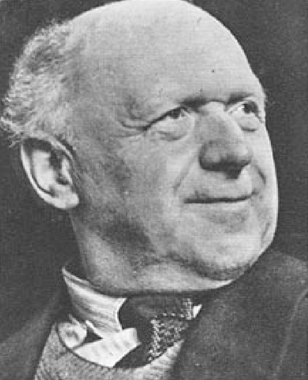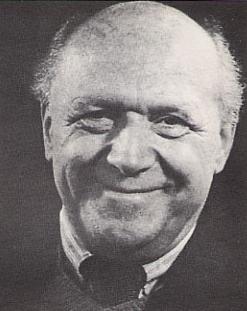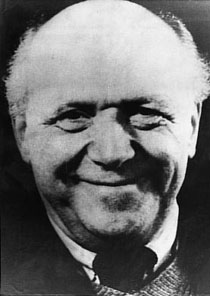<Back to Index>
- Philosopher Otto Neurath, 1882
- Architect Adolf Franz Karl Viktor Maria Loos, 1870
- Minister of Foreign Affairs Andrey Januaryevich Vyshinsky, 1883
PAGE SPONSOR



Otto Neurath (Vienna, December 10, 1882 - Oxford, December 22, 1945) was an Austrian philosopher of science, sociologist, and political economist. Before he was forced to flee his native country for Great Britain in the wake of the Nazi occupation, Neurath was one of the leading figures of the Vienna Circle.
Neurath was born in Vienna, the son of Wilhelm Neurath (1840 – 1901), a well known political economist at the time. He studied mathematics in Vienna and gained his Ph.D. in the department of Political Science and Statistics at the University of Berlin.
He married Anna Schapire in 1907. She died as a result of childbirth (Paul Neurath) in 1911, and he married a close friend, the mathematician and philosopher Olga Hahn. Perhaps because of Olga's blindness and then because of the outbreak of war, his son, the sociologist Paul Neurath was sent to a children's home outside Vienna, where Neurath's mother lived, and returned to live with his father and Olga when he was nine years old.
Neurath taught political economy at the Neue Wiener Handelsakademie (New College of Commerce, Vienna) until war broke out. Subsequently he became director of the Deutsches Kriegwirtschaftsmuseum (German Museum of War Economy, later the Deutsches Wirtschaftmuseum) at Leipzig. Wolfgang Schumann, known from the Dürerbund for which Neurath had written many articles, urged him to work out a plan for socialization. Neurath joined the German Social Democratic Party in 1918 - 19 and ran an office for central economic planning in Munich. When the Bavarian Soviet Republic was defeated, Neurath was imprisoned but returned to Austria after intervention from the Austrian government. While in prison he wrote "Anti - Spengler", a critical attack on Oswald Spengler's "Decline of the West".
In Vienna, he became secretary for the Austrian Association for Housing and Small Gardens (Verband für Siedlungs-und Kleingarenwesen), a collection of self - help groups that set out to provide housing and garden plots to its members. In 1923, he became the director of a new museum for housing and city planning (Siedlungsmuseum). In 1925 he opened the Gesellschafts - und Wirtschaftsmuseum, or "Social and Economic Museum", which led him to work on graphic design and visual education. With the illustrator Gerd Arntz and with Marie Reidemeister (who he would later marry), Neurath created Isotype, a symbolic way of representing quantitative information via easily interpretable icons.
During the 1920s, Neurath also became an ardent logical positivist, and was the main author of the Vienna Circle manifesto. He was the driving force behind the Unity of Science movement and the International Encyclopedia of Unified Science. During the 1930s, he also began promoting Isotype as an International Picture Language, connecting it both with the adult education movement and with the Internationalist passion for new and artificial languages, although he stressed in talks and correspondence that Isotype was not intended to be a stand alone language, and was limited in what it could communicate.
Austria after the Anschluss was no place for Marxists. Neurath was a socialist of Jewish heritage, and had been active in the construction of Red Vienna. He and his wife fled, first to Holland. There Olga died and after the Luftwaffe bombing of Rotterdam he fled with Marie Reidemeister to England, crossing the Channel with other refugees in an open boat. He and Marie married after a period interned on the Isle of Man (Neurath was in Onchan camp). In England, he and Marie set up the Isotype Institute in Oxford and he was asked to advise on, and design Isotype charts for, the intended redevelopment of the slums of Bilston, near Wolverhampton. Neurath died, suddenly and unexpectedly in December 1945. After his death, Marie Neurath continued the work of the Isotype Institute, publishing Neurath's writings posthumously, completing projects he had started and writing many children's books using the Isotype system, until her death in the 1980s.
Most work by and about Neurath is still available only in German. However he also wrote in English, using Ogden's Basic English. His scientific papers are held at the Noord - Hollands Archief in
Haarlem; the Otto and Marie Neurath Isotype Collection is held in the
Department of Typography & Graphic Communication at the University of Reading in England. In one of his later and most important works, Physicalism,
Neurath completely transformed the nature of the logical positivist
discussion of the program of unifying the sciences. Neurath delineates
and explains his points of agreement with the general principles of the
positivist program and its conceptual bases: He
then rejects the positivist treatment of language in general and, in
particular, some of Wittgenstein's early fundamental ideas. First
Neurath rejects isomorphism between language and reality as useless
metaphysical speculation, which would call for explaining how words and
sentences could represent things in the external world. Instead,
Neurath proposed that language and reality coincide — that reality
consists in simply the totality of previously verified sentences in the
language, and "truth" of a sentence is about its relationship to the
totality of already verified sentences. Either a sentence failing to
"concord" (or cohere) with the totality of the sentences already
verified, should be considered false, or that some of that totality's
propositions must in some way be modified. He thus views truth as a
question of internal coherence of
linguistic assertions, rather than anything to do with facts or other
entities in the world. Moreover, the criterion of verification is to be
applied to the system as a whole (semantic holism) and not to single sentences. Such ideas exercised a profound influence over the holistic verificationism of W.V.O. Quine. In fact, it was Quine, in Word and Object,
who made famous Neurath's analogy which compares the holistic nature of
language and consequently scientific verification with the construction
of a boat which is already at sea: We
are like sailors who on the open sea must reconstruct their ship but
are never able to start afresh from the bottom. Where a beam is taken
away a new one must at once be put there, and for this the rest of the
ship is used as support. In this way, by using the old beams and
driftwood the ship can be shaped entirely anew, but only by gradual
reconstruction. Stanovich discusses this metaphor in context of memes and memeplexes and refers to this metaphor as a "Neurathian bootstrap". Neurath
also went on to reject the notion that science should be reconstructed
in terms of sense data, since perceptual experiences are too subjective
to constitute a valid foundation for the formal reconstruction of
science. The phenomenological language
that most positivists were still emphasizing was to be replaced, in his
view, with the language of mathematical physics. This would allow for
the objective formulations required because it is based on
spatio - temporal coordinates. Such a physicalistic approach
to the sciences would facilitiate the elimination of every residual
element of metaphysics because it would permit them to be reduced to a
system of assertions relative to physical facts. Finally,
Neurath suggested that since language itself is a physical system,
because it is made up of an ordered succession of sounds or symbols, it
is capable of describing its own structure without contradiction. These ideas helped form the foundation of the sort of physicalism which is still today the dominant position with regard to metaphysics and, especially, the philosophy of mind.